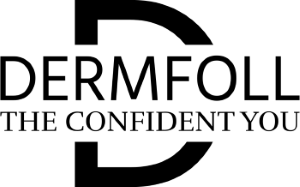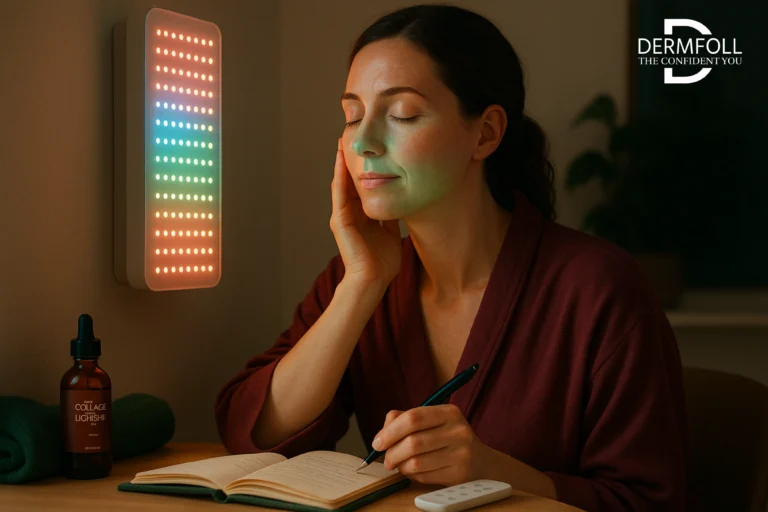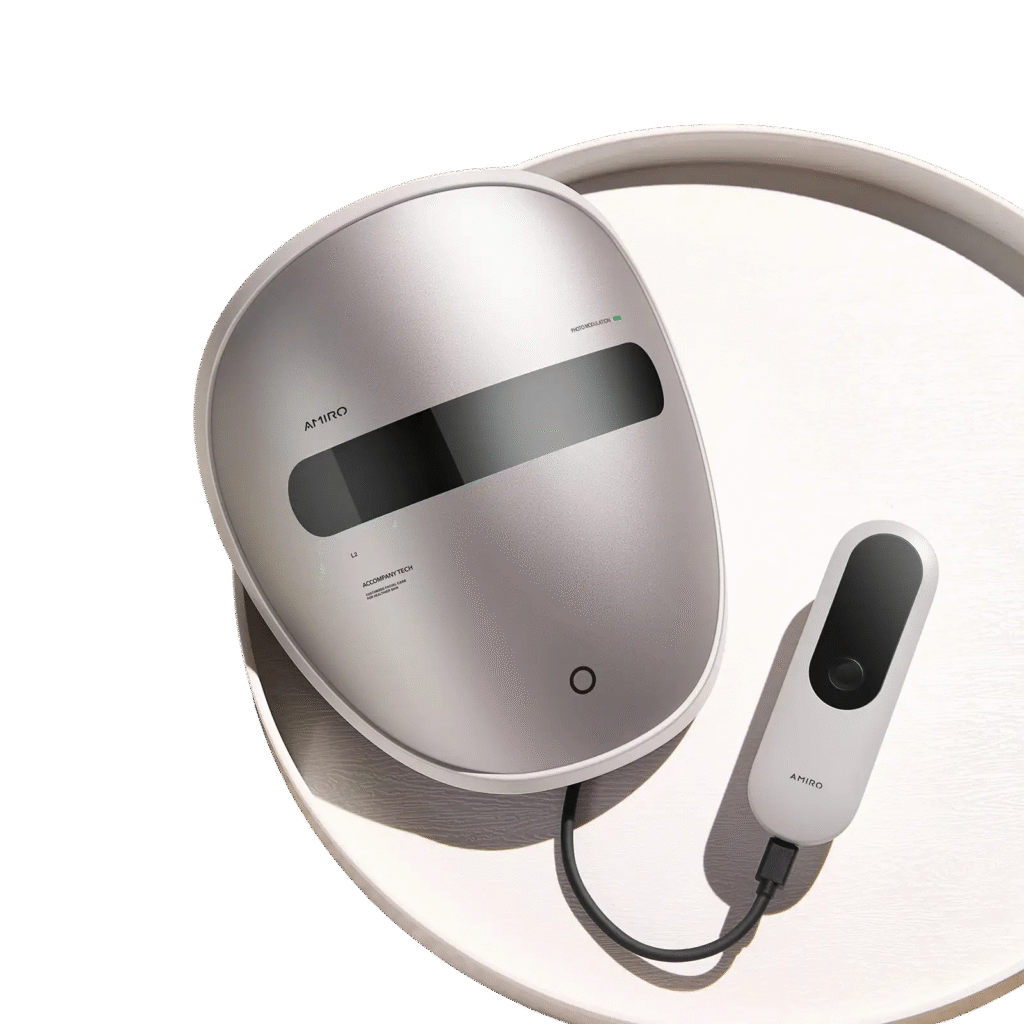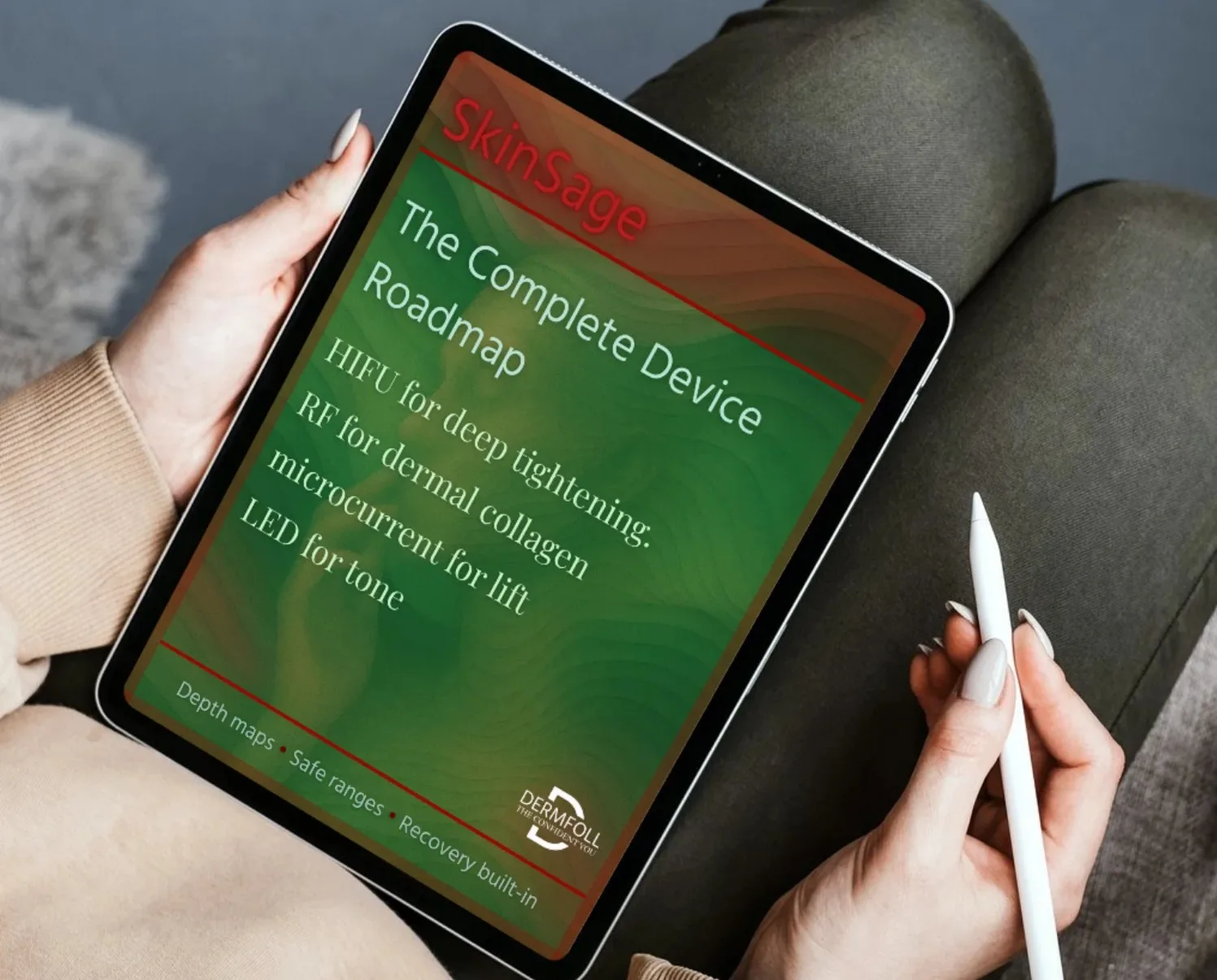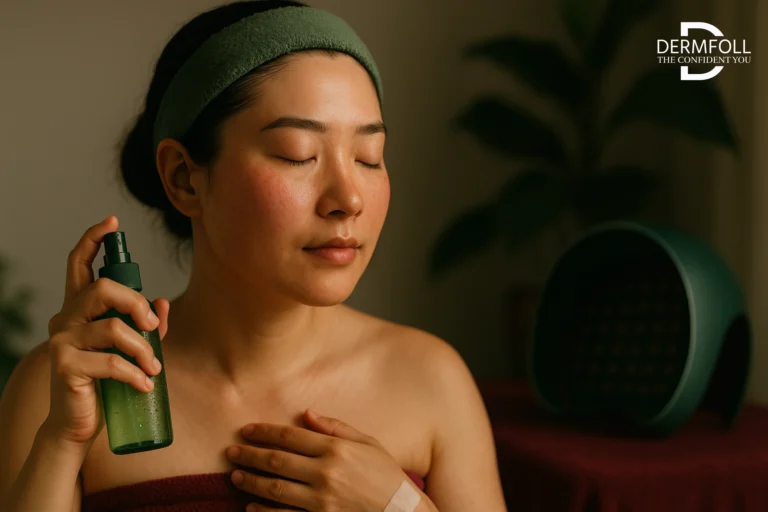The Science Behind: LED Therapy Color Benefits
Let’s speak about how LED light treatment works. You’re in the perfect place if you’ve ever wondered how light might help your skin heal, tighten, or glow.
Let’s go over it step by step. It’s not hard, just honest, useful information.
Understanding Photobiomodulation: How Light Affects Cells
Think of your skin cells as little factories. They need power to work right, just like any other establishment.
This is where LED light treatment comes in. Your cells actually take up energy from certain wavelengths of light, just like solar panels do with sunlight.
This process is called photobiomodulation.
It just means light is triggering your skin cells to work better, from producing more energy (in the form of ATP) to repairing damage.
Think of it as giving your skin a gentle nudge to be more active and healthier.
As one clinical reference noted,
“Photobiomodulation induces biological responses via light-absorbing chromophores, particularly in the mitochondria, which play a critical role in dermal regeneration.”
Depth Matters: How Light Penetration Varies Across Wavelengths
Here’s where things get a little more interesting, and important if you’re considering the right LED light device or LED light tool.
Different colors of light actually go to different “floors” in your skin. For example:
- Blue light stays near the surface. It’s great for acne since it helps kill bacteria.
- Red light dives a little deeper, targeting collagen and reducing inflammation.
- Near-infrared light? It goes even deeper, reaching the lower dermis and even subcutaneous tissue, helping with healing and elasticity.
knowing the LED therapy color benefits can give you better clarity in what kind of results you get.
“The therapeutic potential of LED light is strongly determined by its penetration depth, which varies by wavelength. This enables tailored skin interventions at precise anatomical levels.”
From Theory to Therapy: Proven Clinical Applications of LED
Now, if you’re wondering whether all this science actually transpires to real results, yes, it absolutely does.
Clinics and at-home users alike have seen impressive outcomes using a LED light device for things like:
- Reducing inflammation after procedures
- Speeding up wound healing
- Soothing sensitive or reactive skin
- Stimulating collagen to smooth fine lines
- Treating acne breakouts (especially with blue light)
The best part? It’s gentle. Non-invasive. And when used properly, it works with your skin, not against it.
As one peer-reviewed source put it,
“Clinical trials have consistently demonstrated LED therapy’s efficacy in enhancing skin tone, texture, and barrier function without thermal injury or downtime.”
So… still with me? If any part of that sparked curiosity, whether it’s figuring out which LED light tool suits you best.
Red, Blue, and Beyond: Light Therapy Color Guide
Let’s say you’ve just unboxed your new LED light device, or maybe you’re about to book a facial that uses one.
Either way, the moment you see a panel glowing red, blue, or some other sci-fi color, you might be wondering… what does each color actually do for my skin?
Just like each skincare ingredient has a specific job, each light Different wavelengths in an LED light tool have specific use cases for your skin’s health.
Let’s walk through the big players: red, blue, and beyond.
🔶 Recharge Skin Cells with Targeted Light Energy
CELLRETURN Platinum LED Mask
Multi-wavelength LED therapy boosts collagen and clears acne-causing bacteria effectively.
AMIRO Spectra 5-in-1 LED Light Therapy Facial Mask
Customizable color settings rejuvenate skin tone and enhance cellular energy balance.
Red Light Therapy: Collagen Synthesis and Wrinkle Reduction
Think of red light therapy as your skin’s personal trainer. It doesn’t just make things look better on the surface, it actually works deep inside to strengthen and rebuild.
Red and near-infrared wavelengths penetrate the skin more deeply than other colors.
Once they’re in, they help activate your fibroblasts (those are the cells responsible for making collagen and elastin).
That means firmer, plumper skin over time, and fewer fine lines.
Red light boosts ATP production (that’s the energy currency of your cells), which fuels the repair and regeneration process.
One clinical note I found says it perfectly:
“Red and near-infrared wavelengths are proven to stimulate dermal fibroblast activity, enhance mitochondrial function, and improve tissue resilience in aging skin.”
So if you’re after anti-aging results, this wavelength is where to start.
Blue Light Therapy: Antibacterial Action in Acne Treatment
Now, let’s flip to another color, blue light, the breakout buster.
Blue light doesn’t go as deep as red. However, it’s incredibly effective at targeting Cutibacterium acnes (C. acnes). This bacteria being responsible for the inflamed, under-the-skin breakouts.
It’s like sending in a targeted spotlight to clean up oil and bacterial buildup in the upper layers of your skin.
Plus, blue light helps reduce oil production. Less oil = less congestion = fewer breakouts. Pretty straightforward.
And here’s the clinical backup:
“Exposure to blue LED light significantly reduces P. acnes colony counts and has been demonstrated to suppress sebaceous activity without damaging surrounding tissue.”
If acne is your concern, using a LED light tool with a blue setting can be a game-changer.
The Invisible MVP: Why Near-Infrared Light Deserves More Hype
Okay, let’s talk about the wavelength that doesn’t get nearly enough love: near-infrared light.
You can’t see it, literally, it’s invisible, but trust me, your skin feels it.
While red light handles surface-level concerns like collagen and fine lines, near-infrared (NIR) takes things several layers deeper.
We’re talking below the dermis and into the foundational layers of your skin, where long-term change happens.
It’s kind of like the quiet overachiever in class: not loud, not showy, but always delivering results.
What’s it doing down there? It’s reducing inflammation, improving circulation, and speeding up healing.
Honestly, if your skin is feeling tired, sluggish, or post-procedure sensitive, this is the wavelength that shows up with a warm compress and a cup of tea.
One clinical paper put it beautifully
“NIR light exhibits the greatest penetration depth among non-invasive wavelengths and has demonstrated biologically significant effects on tissue repair and inflammatory modulation.”
So, if your LED light tool includes NIR, give it a high-five.
It might not glow visibly, but it’s working overtime behind the scenes.
Multispectral Protocols: Customizing LED Treatment Plans
In some senarios and device models, you don’t have to choose just one color.
Many LED light sources today feature multispectral protocols, meaning they may mix or cycle across multiple wavelengths in one session.
Why? Because skin disorders are rarely one-note.
For instance:
- Red light can smooth fine lines and support healing.
- Blue light can treat acne and calm inflammation.
- Add in near-infrared, and you’re boosting deep tissue repair.
This layered approach allows you (or your practitioner) to tailor the treatment to your unique skin goals, whether that’s anti-aging, clearing breakouts, or just giving your skin a healthy recharge.
As summed up in one study,
“Combined-spectrum LED protocols allow for multi-targeted intervention by addressing epidermal, dermal, and microbiological factors simultaneously.”
So if you’ve been staring at those colorful lights wondering what they’re doing for your skin – now you know.
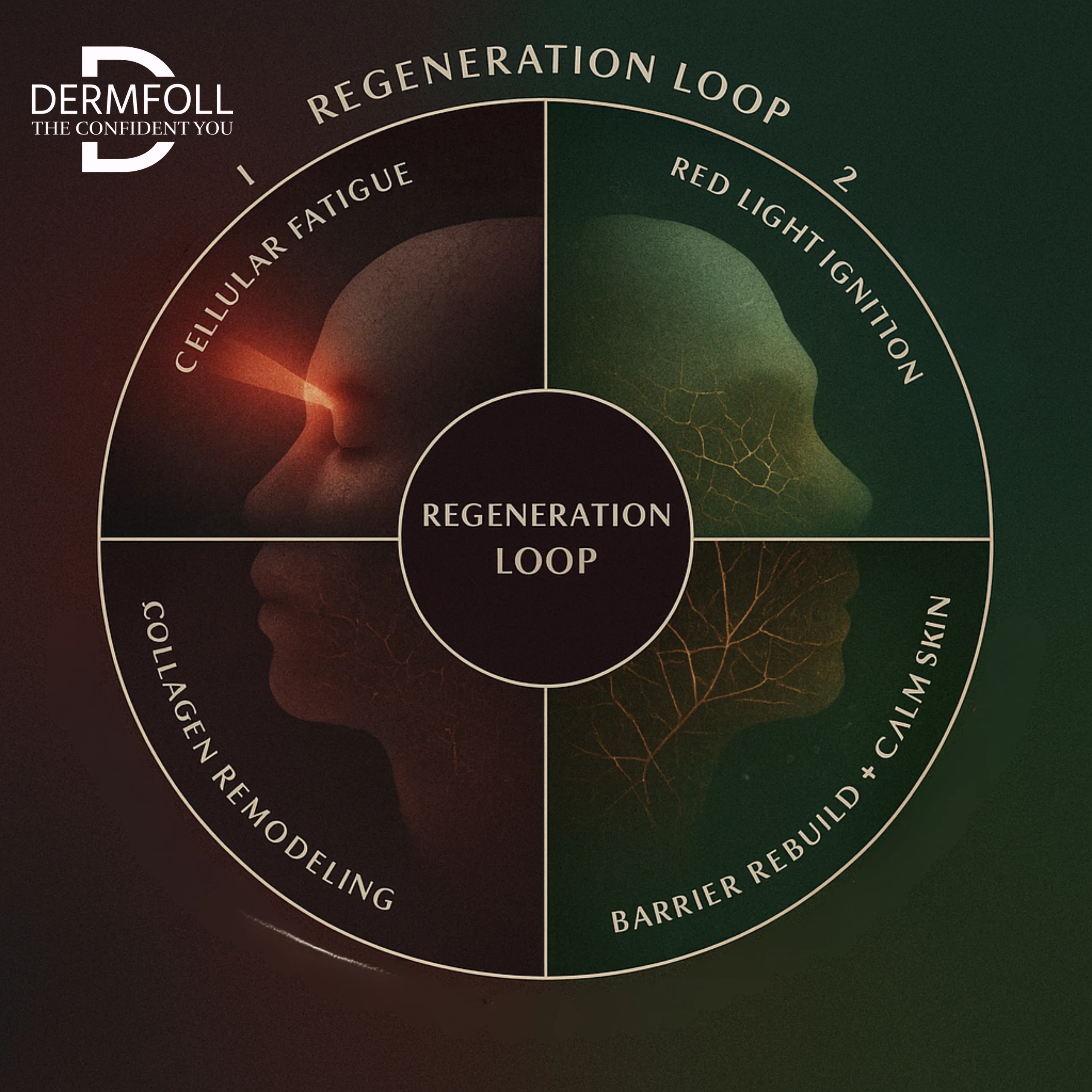
🔶 Clarify, Calm, and Restore with Precision LED Therapy
CELLRETURN Platinum LED Mask
Red, Blue, and NIR wavelengths refine texture and soothe inflammation simultaneously.
AMIRO Spectra 5-in-1 LED Light Therapy Facial Mask
Blue and yellow modes reduce breakouts and brighten uneven pigmentation safely.
Cellular Recharge: How LED Light Stimulates Skin Regeneration
So here’s the thing. Your skin is already amazing at healing itself, it’s basically in regeneration mode 24/7.
But sometimes, whether owing to stress, aging, breakouts, or just life in general as it usually does, your skin’s internal battery might get a little… slow.
Enter LED light treatment, this tech could potentially recharge your skin.
Let’s walk over exactly how this works, starting at the deepest, most cellular level.
Mitochondrial Activation and ATP Production
Let’s nerd out for a second
Inside every single skin cell, there’s a small structure called the mitochondrion, you probably remember it as “the powerhouse of the cell” from science class.
When you use an LED light source, especially one with red or near-infrared wavelengths, the light goes straight to these mitochondria and wakes them up.
It’s like plugging your phone into a fast charger.
What happens next? These stimulated mitochondria pump out more ATP (that’s cellular energy).
And giving your skin the fuel it needs to accomplish things like renew faster, repair damage, and produce better-quality cells .
A quote I love from the research says:
“Light-induced ATP synthesis enhances cellular performance and accelerates regeneration at both the epidermal and dermal levels.”
Basically, this is where skin revival starts.
Fibroblast Stimulation and Matrix Remodeling
Now that your skin cells are powered up, they call in the heavy lifters: fibroblasts.
These are the cells that build and maintain your skin’s support system, collagen, elastin, and all the good stuff that keeps your face lifted, plump, and smooth.
When fibroblasts are energized by red or NIR light (two of the most effective LED therapy color benefits, by the way), they start ramping up production.
This process is known as matrix remodeling. In simpler terms? Your skin’s architecture gets a structural upgrade.
“Stimulation of fibroblast activity under LED exposure increases collagen density and improves dermal integrity, leading to visible enhancement of skin elasticity.”
In short, your LED light tool isn’t just surface-level. It’s working at the blueprint level of your skin.
Inflammation Modulation and Skin Barrier Repair
Now, let’s talk calm, not just collagen.
One of the lesser-known, but impactful benefits of LED light therapy is its ability to soothe inflammation.
Whether you’re dealing with rosacea, post-procedure redness, or just sensitive, reactive skin, red and NIR wavelengths help calm the storm.
They do this by dialing down pro-inflammatory cytokines (the chemical messengers that yell “fire!” in your skin). And reinforcing your skin barrier, the outer layer that keeps the good stuff in and the bad stuff out.
And guess what? A healthy barrier is the foundation for glowing, balanced skin.
“LED-induced modulation of inflammatory pathways contributes to improved skin tolerance and enhanced barrier function in compromised skin types.”
CONCLUSION
So there you have it, LED light therapy. This tech is rooted in actual science and has the power to support your skin at every level.
Let’s recap:
- Photobiomodulation is the process that powers it all, your skin cells absorb light and turn it into energy. Think mitochondria with a triple espresso.
- Wavelengths matter. Red, blue, and near-infrared light all penetrate the skin to different depths, delivering specific benefits. This is where your light therapy color guide comes in handy.
- Whether you’re after firmer skin, fewer breakouts, or better healing. Understanding your LED therapy color benefits means you can use your LED light device with real intention.
- And yes, there’s strong clinical evidence behind it all. This isn’t fluff. It’s fact-backed skincare you can feel good about.
🔶 Multi-Spectrum Light for Firmer, Brighter, Balanced Skin
CELLRETURN Platinum LED Mask
Delivers deep dermal stimulation for firmness, radiance, and visible clarity improvement.
AMIRO Spectra 5-in-1 LED Light Therapy Facial Mask
5-color spectrum supports collagen repair, barrier health, and post-acne recovery.
But this is just the beginning.
Because while LED works wonders on the surface (and just beneath it), there’s a whole other level of magic that happens when you pair it with the deep-heating power of Radio Frequency.
👉 In our next post, we’re diving into:
- How RF brings the heat (literally) and helps tighten skin from within.
- Why layering LED and RF is like giving your skin a team of specialists.
- And how combo protocols can boost comfort, minimize downtime, and seriously level up your results.
If you’ve ever been curious about collagen, contour, or what “multi-layer skin rejuvenation” really means, trust me – you’re going to want to stick around.
